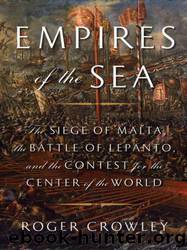Empires of the Sea: The Siege of Malta, the Battle of Lepanto, and the Contest for the Center of the World by Roger Crowley

Author:Roger Crowley
Language: eng
Format: mobi
Tags: War, History
ISBN: 9781588367334
Publisher: Random House
Published: 2008-07-01T00:00:00+00:00
The bombardment of Birgu (B); a troop of janissaries in their plumed headdresses (O); Mustapha (L) and Piyale (N) watching from horseback
Despite the capability to reduce the fortifications to mountains of rubble, Mustapha was beset by difficulties, not least by the miniature scale of the battlefield. The front at Birgu was one thousand yards wide; that at Senglea less. No matter how many thousand men he had, only a fraction could be deployed at any one time. A small number of defenders, well armored and protected by makeshift walls and ramparts, could fight at no particular disadvantage. He was worried too by muffled reports from spies and captives of the buildup of men and ships thirty miles away in Sicily. And by the height of summer, he had sickness in the camp. No army of the time took such care with the hygiene and organization of its encampments as the Ottomans, but Malta was unfavorable terrain. The army had had to camp in low-lying marshy land around the available water sources, which the knights had taken care to contaminate. In the sweltering summer heat, in a landscape strewn with unburied corpses, the men started to succumb to typhoid and dysentery. Time was pressing down on the Ottoman commanders.
Mustapha proceeded with all speed to try to break the defense. In the first few days after defeat at the Spur, attempts were made to cross Senglea’s ditch with a bridge of masts. The defenders made several attempts to burn it—the grand master’s nephew, hideously visible in rich armor, was shot dead in one incautious assault—but ultimately they were successful. Undeterred, Mustapha put his miners to work tunneling through the solid rock to lay explosives charges, covering the noise of the work with gunfire. Only luck saved Senglea; on July 28 “by the will of God,” the miners were probing with a spear to see how close they were to the surface, when the men on the wall spotted the spear tip protruding from the ground. They dug countermines and burst into the tunnel, hurling incendiaries and chasing the miners out. The shaft was blocked up. Mustapha was visibly discouraged by this failure—it had represented a huge effort, but the battle of wits went on. When the Ottomans bombarded the streets, La Valette had stone walls built across them. When the arquebusiers started to pick off laborers repairing the ramparts, Marshal de Robles screened his men with ships’ sails that forced the marksmen to shoot blind. Attempts to fill in the ditches were countered by night sorties to clear them out. As the outer defenses collapsed under cannon fire, the defenders responded by constructing retrenchments—makeshift fallback barriers of earth and stone—to staunch the crumbling front line, demolishing houses for building materials. In the rubble-strewn wasteland each side attempted to maintain positions of cross fire and to build barriers to protect their own men. Siege warfare required huge quantities of human labor, but the Ottomans had the resources to work on an immense scale:
Download
This site does not store any files on its server. We only index and link to content provided by other sites. Please contact the content providers to delete copyright contents if any and email us, we'll remove relevant links or contents immediately.
| Buddhism | Christianity |
| Ethnic & Tribal | General |
| Hinduism | Islam |
| Judaism | New Age, Mythology & Occult |
| Religion, Politics & State |
Cecilia; Or, Memoirs of an Heiress — Volume 1 by Fanny Burney(31333)
Cecilia; Or, Memoirs of an Heiress — Volume 3 by Fanny Burney(30934)
Cecilia; Or, Memoirs of an Heiress — Volume 2 by Fanny Burney(30889)
The Secret History by Donna Tartt(16623)
Sapiens: A Brief History of Humankind by Yuval Noah Harari(13053)
Leonardo da Vinci by Walter Isaacson(11903)
The Radium Girls by Kate Moore(10907)
Sapiens by Yuval Noah Harari(4537)
The Wind in My Hair by Masih Alinejad(4424)
How Democracies Die by Steven Levitsky & Daniel Ziblatt(4399)
Homo Deus: A Brief History of Tomorrow by Yuval Noah Harari(4279)
Endurance: Shackleton's Incredible Voyage by Alfred Lansing(3844)
The Silk Roads by Peter Frankopan(3760)
Man's Search for Meaning by Viktor Frankl(3634)
Millionaire: The Philanderer, Gambler, and Duelist Who Invented Modern Finance by Janet Gleeson(3569)
The Rape of Nanking by Iris Chang(3516)
Hitler in Los Angeles by Steven J. Ross(3437)
The Motorcycle Diaries by Ernesto Che Guevara(3332)
Joan of Arc by Mary Gordon(3258)
